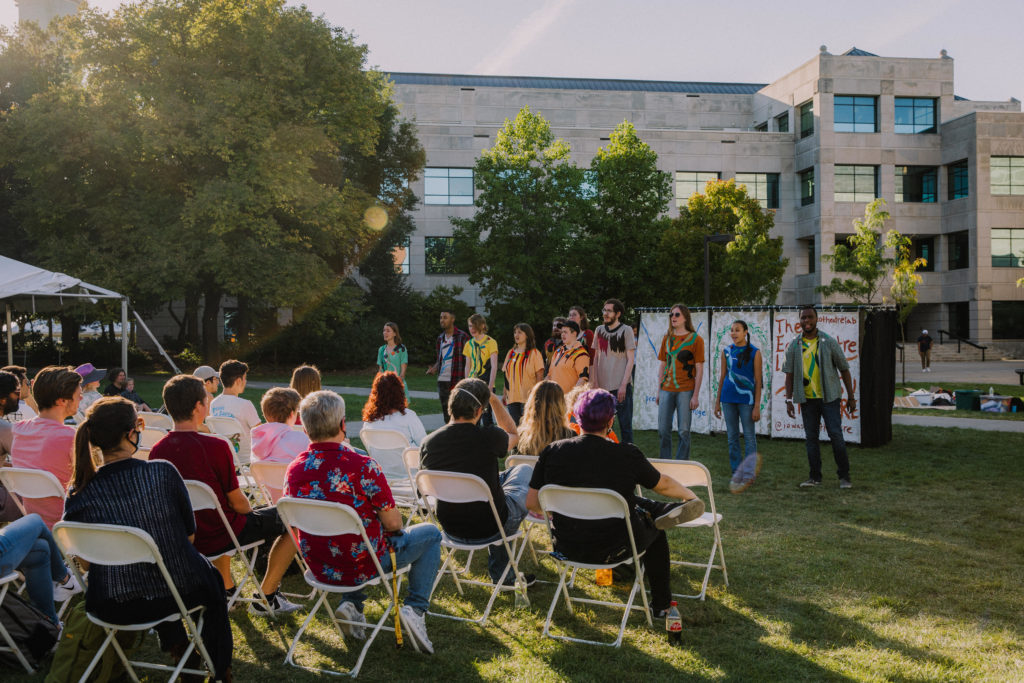Laura Perry, PhD, is the assistant director for research and public engagement in the Center for the Humanities.

Culture and Environmental Crisis
1 pm | Wednesday, February 28, 2024
A panel discussion featuring Faculty Book Celebration keynote lecturer Nicole Seymour and Ursula Heise, the Marcia H. Howard Chair in Literary Studies Department of English and Institute of the Environment & Sustainability at the University of California, Los Angeles.
In Defense of Tackiness: The Queer Environmental Politics of Glitter
4 pm | Wednesday, February 28, 2024
Nicole Seymour is a professor of English, California State University, Fullerton, and author of Glitter, an environmental-cultural history of a substance often dismissed as frivolous.
RSVPs appreciated, all are welcome.
On February 28, 2024, the Center for the Humanities will host Nicole Seymour as the keynote speaker for the annual Faculty Book Celebration. Seymour is professor of English and graduate advisor for environmental studies at Cal State Fullerton, and works in the environmental humanities, asking how literature and other cultural forms — from documentary film to standup comedy — mediate our relationship to environmental crisis.
In recent years, the environmental humanities has become an important growing field, with scholars and practitioners who investigate how humanities methods can help us understand and address urgent environmental issues. WashU has a thriving ecosystem of faculty, staff and students working in and near the environmental humanities, with too many researchers to name, emerging collaborations between the Center for the Humanities and the new Center for the Environment to support them, and an exciting lineup of environmental events and speakers this spring.
The subjects of environmental humanities research are eclectic — scholars write about literary texts and historical records alongside mushroom lifeways and avian flight paths. Seymour’s acclaimed research and writing shows how that wide-ranging scope is necessary to examine the entangled nature of the worlds we live in today. Her first monograph, Strange Natures: Futurity, Empathy, and the Queer Ecological Imagination (University of Illinois Press, 2013), won the 2015 Ecocriticism Book Award from the Association for the Study of Literature and Environment. Her second, Bad Environmentalism: Irony and Irreverence in the Ecological Age (University of Minnesota Press, 2018), recuperates irreverent and anti-sentimental expressions of environmentalism and was recognized by the Chicago Review of Books as among the “Best Nature Writing of 2018.” Her latest book is Glitter, an environmental-cultural history of that substance from Bloomsbury’s Object Lessons series (edited by Chris Schaberg and Ian Bogost, and now housed at WashU’s Program in Public Scholarship).
I have been a fan of Seymour’s work since graduate school, and a fan of glitter since middle school, so I was first in line to pick up her latest — and it does not disappoint. Glitter traces the activist tactic of glitter-bombing, the queer joys of glam, the class politics of perceived tackiness and excess, and glitter’s simultaneous relationships to natural glimmers and disposable plastics. In anticipation of her visit, I asked Seymour to share some of her current research interests and give us a preview of what’s to come later this month.
Hi! Can’t wait for your visit to WashU next month. One aspect of your writing that stands out is how you skillfully shift in tone throughout your books, from crisis to comedy. There are several moments in Glitter that made me laugh out loud! How do you think about your audience when you’re writing? Are there challenges (or joys) to writing for a series like Object Lessons, which imagines a more public readership?
Writing Glitter for a public audience felt very freeing — I let myself run totally wild, knowing that the serious posturing of academic writing wasn’t in effect. I tried to write in ways that gave me (and hopefully my audience) pleasure, using techniques like narrative present tense, personal anecdotes, listing, alliteration and even rhyming. I also tried to create pleasure around the writing process itself. So I selected one typeface that I found to be beautiful, in which I wrote the whole manuscript. Of course, it was ultimately published in the standard typeface they use for the whole book series, but for my two years of drafting I used Papryus. Just kidding! I used Avenir. I don’t recall how conscious I was of it at the time, but there’s obviously a connection between the arguably indulgent and frivolous nature of some of these writing modes and the indulgent and frivolous nature of glitter.

You’ve engaged with efforts to connect environmental advocacy and humanities methods, like Climate Change Theatre Action. What draws you to projects like that one?
As a professor, I jump at any opportunity to help students feel empowered and connected to others who are “doing the work,” and Climate Change Theatre Action is perfect for that. Coinciding with the biannual UN climate summits, 50 professional playwrights from around the world write five-minute plays related to the climate crisis. Then anyone interested can access them upon request — teachers, activists, community theatre groups, whatever. I love showing students the spreadsheet of the new crop of plays and seeing the vast array of countries and Indigenous nations they represent. Then I let them pick out plays for us to read based on the keywords in the spreadsheet. I like giving them that kind of ownership over the curriculum. In the bigger picture, students see that imagination is crucial for inspiring climate action, and also how humanist forms like theater can help us process the emotions, like fear and hopelessness, that are stymying that action.
Your work is entangled in so many different fields. Are there any emerging areas or topics that excite you in particular, whether in your own research or from other scholars?
It hit me the other day that, if we think in terms of the classical elements of earth, water, air and fire, we’ve just entered the “air” stage of environmental humanities scholarship. To back up for a second: a subfield called the “blue humanities” emerged several years ago in response to how environmental humanists were tending to privilege terrestrial landscapes and their representation — despite the fact that 71% of the Earth’s surface is covered in water. Then in the past three years or so, some really exciting books have insisted that we think about air: Nerea Calvillo’s Aeropolis: Queering Air in Toxicpolluted Worlds, Jean-Thomas Tremblay’s Breathing Aesthetics and Hsuan Hu’s The Smell of Risk: Environmental Disparities and Olfactory Aesthetics. Air is always part of our environment, so when and how do we notice it? How do different populations experience air differently? How can we represent such disparities? I think these are fascinating and important questions.
Could you give us a sense of your current interests, in your research and writing?
I’ve recently started a new project with my best friend, Darin DeWitt, who’s a political scientist, which we’re calling “Conservative Camp.” We’re interested in the recent adoption of camp sensibilities and aesthetics on the far right — so, think the “QAnon Shaman” at the January 6th insurrection, wearing his gaudy fur headdress and flamboyant facepaint. There’s long been an assumption that campiness is unique to LGBTQ+ or leftist communities, but there’s clearly more to that story.
We’re inspired by scholars like Nick Marx and Matt Sienkiewicz, who have recently shown that humor is a rising force on the far right, such as in white supremacist groups — despite the leftist party line that there’s no such thing as conservative comedy. (I highly recommend their book, That’s Not Funny: How the Right Makes Comedy Work for Them.) It’s easy, and more pleasant, to just ignore these phenomena. But we think it’s crucial to study them if we want to understand and intervene in the way the world is going.
Headline photo by Alexander Grey via Unsplash





